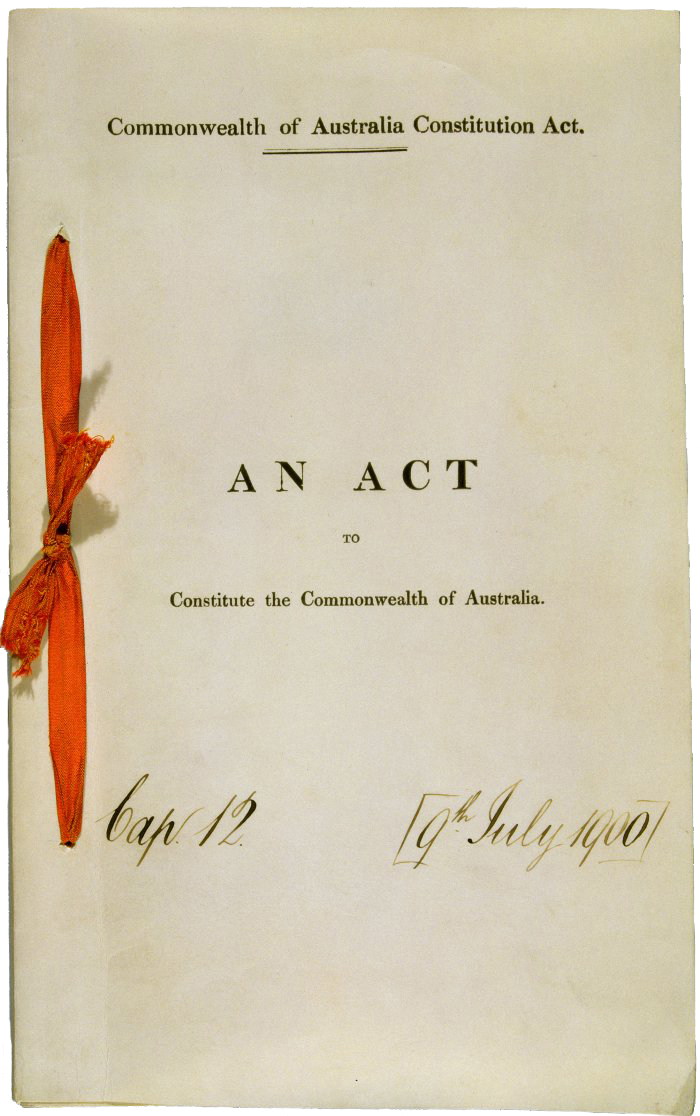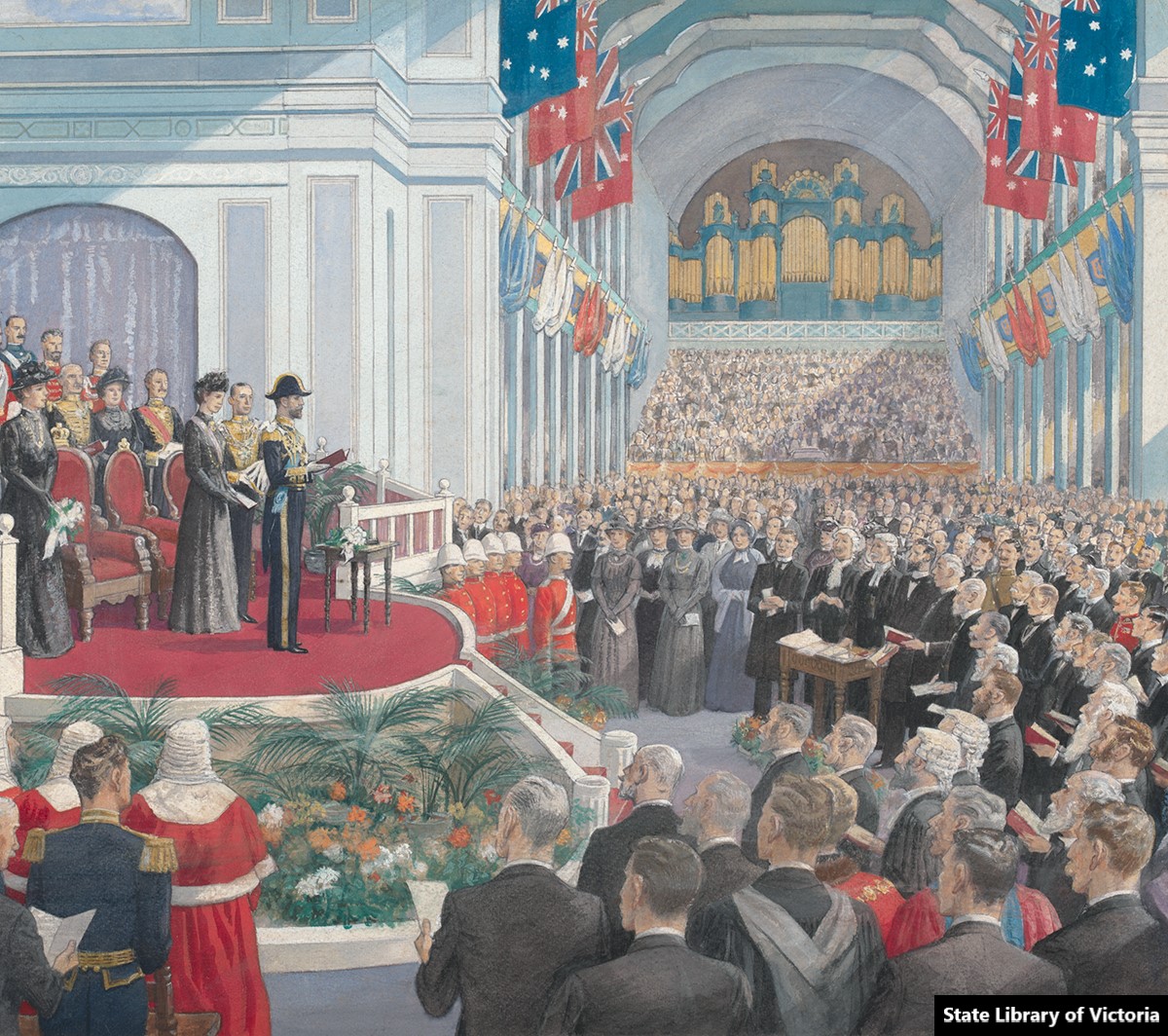What is Federation?
Australia became a nation on 1 January 1901 when six British colonies—New South Wales, Victoria, Queensland, South Australia, Western Australia and Tasmania—united to form the Commonwealth of Australia. This process is known as Federation.
Watch this video to learn how Australians joined together to form a new nation.
The path to Federation
For at least 50 000 years, Aboriginal and Torres Strait Islander peoples have lived on these lands and practiced traditional cultures and languages. From the late 1700s, British colonies were established. By the late 1800s, these colonies had their own parliaments but were still subject to the law-making power of the British Parliament.
Each colony had its own government and laws, including its own railway system, postage stamps and tariffs—taxes. This caused many problems and people began to think about the benefits of uniting as one nation.
They argued a national government would:
- Increase trade and strengthen the economies of each colony by removing internal tariffs and borders.
- Create a national defence force to protect the continent in case of invasion.
- Better control immigration.
- Create a more democratic system of government, in which women could vote.
Federation timeline
1889 - Sir Henry Parkes, Premier of New South Wales, urges the colonies to federate.
1890 - The Australasian Federation Conference recommends a national convention be held to draft a constitution for a Commonwealth of Australia.
1891 - The first National Australasian Convention is held in Sydney and drafts a constitution.
1891 – 94 - Economic depression means the colonial parliaments lose interest in Federation.
1893 - A people's conference in Corowa, New South Wales, urges the colonial parliaments to hold a new convention to decide on a draft constitution.
1896 - A second people's conference in Bathurst, New South Wales, renews calls for another Federation convention.
1897 – 98 - The second National Australasian Convention meets in Adelaide, Sydney and Melbourne, and agrees to the constitution.
1898 - Referendums are held in New South Wales, Victoria, South Australia and Tasmania to approve the constitution. It is agreed to by all but New South Wales.
1899 - In January a secret premiers' meeting agrees to several changes to the constitution. Between April and July referendums are held in South Australia, New South Wales, Victoria and Tasmania at which a majority vote 'yes' to the bill. In September Queensland voters agree to the constitution.
1900 - In March a delegation travels to London to present the constitution to the British Parliament. On 5 July the British Parliament passes the Commonwealth of Australia Constitution Act 1900. On 9 July Queen Victoria signs the Commonwealth of Australia Constitution Act 1900. On 31 July Western Australia holds a referendum at which an overwhelming majority of voters approve the Constitution.
1901 - On 1 January the Commonwealth of Australia is proclaimed in Centennial Park, Sydney. On 29 and 30 March the first federal election is held. On 9 May the Duke of Cornwall and York (later King George V) opens the first Parliament of the Commonwealth of Australia in the Exhibition Building in Melbourne.
What is the Australian Constitution?
The Australian Constitution is the set of rules for how Australia is run. It sets out how the Australian and state parliaments share the power to make laws. It also details the roles of the government and the High Court of Australia, and some of the rights of Australian citizens, such as the right to religious freedom. It came into effect on 1 January 1901.
The Commonwealth of Australia Constitution Act 1900 granted permission to the six Australian colonies, which were still subject to British law, to form their own national government in accordance with the Constitution.
Watch this video for a snapshot on the Australian Constitution.

Image: Commonwealth of Australia Constitution Act. Courtesy of Parliament House Art Collection, Art Services Parliament House.
The first Parliament of the Commonwealth of Australia
The first Parliament of the Commonwealth of Australia was opened at noon on 9 May 1901 by the Duke of Cornwall and York (later King George V). The ceremony took place in the Exhibition Building, Melbourne, and was attended by over 12 000 guests.
Members of parliament were sworn-in by the Governor-General and then travelled by foot and horse-drawn carriage to Victoria's Parliament House.
The Victorian Parliament House was the temporary home of the Parliament until 1927, when a new Parliament House opened in Canberra. During this time, the Victorian Parliament met in the Exhibition Building.
The opening of Parliament was marked by two weeks of celebrations. The enthusiasm with which Australians greeted Federation and the first Parliament, demonstrated the nation was eager to unite as 'one people'.

Image: The Duke of Cornwall and York opens the first federal Parliament, 9 May 1901. Courtesy of the State Library of Victoria.
Want more information?
The Parliamentary Education Office develop and maintain resources to educate Australians about, and inspire their enthusiasm for Australia’s parliamentary democracy. Check out their resources on their website.
Parliament Explained series
Across the next six months, the About the House team is exploring the topics such as: democracy, federation, government and parliament.
Follow our series on our Facebook Page.